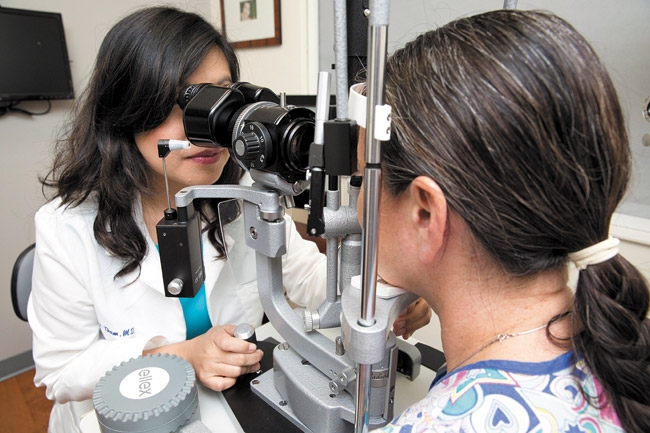Uveitis Untreated Causes Blindness
Dr. Vivien Tham
Ophthalmologist and president of Pacific Vision Institute of Hawaii
Where did receive your schooling and training?
I’m from Hong Kong, where my father was an ophthalmologist. I graduated from medical school in the United Kingdom at the University of London. I did my internship at Brown University in Rhode Island, my residency at UCLA Jules Stein Eye Institute, and my fellowship at UCSan Francisco Proctor Foundation, studying uveitis and corneal diseases. I worked for Kaiser for 11 years, and I just opened my own practice, the Pacific Vision Institute of Hawaii, in July.
mw-dih-092513-drvivientham-2
What is your area of specialty?
I specialize in cataract surgery and in cornea and external diseases, which deal with corneal transplants and conditions of the front of the eye. I also specialize in uveitis, which is an inflammatory condition of the eye. Inflammation in the joint would be called arthritis, while inflammation inside the eye is uveitis. It can happen at any age, even affecting children, but it most commonly affects people between 20 to 60 years old. Uveitis affects one in 4,500 people and is responsible for 10 to 20 percent of all blindness in the U.S. It can permanently damage the inside of the eye, and it can be difficult to diagnose. Primary care doctors or ER doctors will see a red eye and think it’s conjunctivitis, which most of the time it is, but sometimes it actually can be uveitis, which is a lot more serious. Uveitis is so complex that even general ophthalmologists prefer not to take care of it.
What causes uveitis?
There are four anatomical classifications. The most common type is anterior uveitis, which affects the front of the eye. It is generally less complicated and less damaging than the other types. Inflammation in the middle part of the eyes is called intermediate uveitis, and then there’s posterior uveitis, which affects the back of the eye. The fourth is pan-uveitis, where everything is affected.
Each of those types can be classified further as coming from infectious or non-infectious causes. Infectious causes include syphilis and TB. It might even be secondary syphilis, meaning they got it from their mother when they were born. Herpes is another infectious cause of uveitis. Quite commonly herpes 1, which causes mouth sores, can get into the eye. The virus is within the body and it can manifest itself in the eye.
Non-infectious causes can be broken down into conditions that affect the whole body and conditions that affect just the eyeball itself. The whole body can be affected by autoimmune-related conditions like lupus, rheumatoid arthritis and sarcoidosis, or certain genetic conditions like ankylosing spondylitis that cause inflammation throughout the body and especially in the eye. Sometimes the symptoms present only in the eye, when they actually have a condition affecting them systemically.
The most common symptoms are light sensitivity, where shining light in one eye causes pain in the other eye, redness in the eye, pain, blurry vision, floaters. But you can have those and it could just be pinkeye. That’s why it’s hard for even regular doctors to distinguish it.
What treatment options are available?
When a patient comes in, I do a thorough exam. When I see that someone has inflammation, diagnostic tests are required. I use the new OCT (optical coherence tomography) machine that uses near-infrared light and scans a 3-D model of microscopic structures. It allows you to see any swelling or bleeding. It helps us to not only diagnose the condition, but to treat it and monitor the progress.
How does blindness occur?
People lose vision because inflammation can cause scarring in the eyes. It also can cause glaucoma and cataracts as well as swelling or abnormal growth of vessels on the retina. Sometimes, fluid can peel off the retina and permanently scar the eye, causing the person to lose vision. Early diagnosis and treatment by a specialist are important. We usually do a blood test to confirm any infections or autoimmune conditions.
Then we decide how to treat the patient. Medications to suppress the immune response is the main treatment once we have ruled out infection. The most common is steroid eyedrops. Sometimes that’s not enough, especially if they have inflammation in the back of the eye. Then we would give a steroid injection around or in the eye. Often, we give steroid medication by mouth.
Can uveitis be cured?
No, but it can be controlled. My job is to keep the inflammation under control and minimize the damage. I am actively involved in research to advance our understanding of uveitis, because there is still so much to learn.






